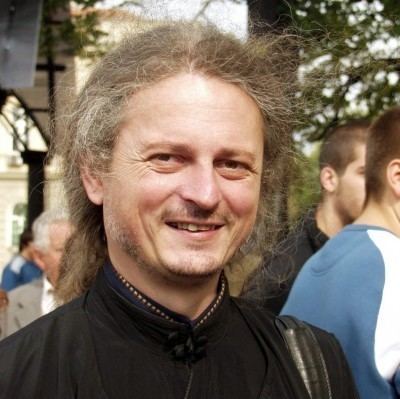Nationality Serbian Name Zoran Djurovic | Role Artist | |
 | ||
Born November 12, 1968 (age 56) ( 1968-11-12 ) Bar, Montenegro | ||
Zoran Djurović (born November 12, 1968) is a Serbian artist, priest, and theologian.
Contents
Biography
Djurovic lived in Sutomore where he finished elementary school and Gymnasium in Bar. He studied design at the Gymnasium Slobodan Škerović in Podgorica, in the class of professor Dragoljub Bato Brajović, a student of Milo Milunović. He was devoted to comics and illustrations. His role models were John Buscema, Burne Hogarth, William Vance, and Frank Frazetta.
He graduated from the Theological Faculty of the Serbian Orthodox Church in Belgrade in 1995. The formation of his theological ideas in this period was specially influenced by Dobrivoje Midić (the latter Bishop of Požarevac-Braničevo, Ignatius), a follower of John Zizioulas and "revolutionary" Greek theologians. He frequently visits Peter Jevremović, Gavrilo Marković, Nenad Ilić, Vladimir Vukašinović, and other prominent figures from Belgrade's intellectual and artistic circles. He has served as a deacon since 1992 in the Monastery of the Presentation in Belgrade and in the St. John the Baptist Church in Mirijevo. He advocated frequent communion and “Return to the Fathers” at the theological faculty and in parishes. He has also taught Byzantine painting in 1994 at the University of the Third Age in Belgrade.
Djurovic enrolled in post-graduate studies in History of Philosophy (mentor Slobodan Žunjić) at The University of Belgrade Faculty of Philosophy, without taking doctorate because of the parish works. In 1996, he took over the parish in Smederevo, where the protagonist of a spiritual change which did not always encounter an approval was. He has held various solo exhibitions (Frescoes, Icons, and Paintings) and participated in numerous collective exhibitions in Serbia, Montenegro, and Italy. He has published various comic strips and illustrations in newspapers, magazines, and books. In 2001, he directed four TV transmissions about Christianity on Smederevo Television. The series was banned because of the method Djurovic used, which was considered too provocative. He was one of the protest leaders in Smederevo, which led to the fall of Slobodan Milošević.
Not wishing to be politically engaged, Djurovic left his country 2002 and moved to Rome, where he studied at Institutum Patristicum Augustinianum of the Pontifical Lateran University. In January 2007, he acquired a license in theology and patristic sciences.
He received his Doctorate in Theology and Patristic Sciences in June 2010. He studied at Analisi esegetico-teologica, at IPA, under the moderation of the following professors: Vittorino Grossi, OSA (first supervisor), Robert Dodaro, OSA (second mentor and the current president), and Nello Cipriani, OSA (advocatus diaboli). He published his thesis the same year. President of the Institute, Dodaro, said that he would try to apply an innovative research method present in this thesis in future doctoral researches.
He speaks several ancient languages (Greek, Hebrew, Syrian, Latin, Old Church Slavonic) and many modern ones (Slavic languages, Italian, English, Spanish, and French). He is devoted to translating and writing scientific researches and painting.
Painting
Djurovic's early years were characterized by the exploration of different painting and graphic techniques. His range of techniques is vast, so hyper-realistic egg tempera and rudimentary expression in oil paintings and frescoes can be seen, but his techniques tend toward the technology of materials, composition, expression, and psychology of person and figure. Brutal execution was the main characteristic of most of his works until 2002. This expression persisted in the Roman period in certain pictures, especially in oils: landscapes, chtonic animals (cats, bulls, deer), and in one part of the portraits. The treatment in the iconography, on the contrary, has become more sophisticated, taking direction of Byzantine or Renaissance style but always sublimed in mode that the artist and his inherent manner can constantly be recognized. If the earlier period is characterized by adhering to templates, the Roman period shows the originality of the composition solutions as well as of the individual icons. Innovation is conditioned by theological reflections.
Djurovic’s art has been well accepted by many important persons of the Roman Catholic Church, so his paintings adorn the rooms of Pope John Paul II, the Cardinals: Fiorenzo Angelini, Tarcisio Bertone, Gianfranco Ravasi, Tomas Špidlik, bishops (in primis Stanislav Hočevar, Archbishop of Belgrade), the priest-artists (Ivan Marko Rupnik, Giampiero Maria Arabia), and the persons of the culture (e.g., Erri De Luca, Massimo Cacciari). Most of the frescoes and icons were executed in the churches in Lazio: Centro Ecumenico Internazionale per la Riconciliazione (Lavinio), Chiesa del Corpus et Verbum Domini (Lavinio), Santa Maria in Cielo (Villa Claudia), Santi Pio ed Antonio (Anzio), and Santa Barbara (Nettuno). He has painted several large icons for the Institutum Patristicum Augustinianum, including some for the office of the Dean, for the secretary's office, and for the Library. He is currently painting in the churches in Lazio and teaching at the Academy of Fine Arts and Conservation of the Serbian Orthodox Church in Belgrade (Аkademija Srpske Pravoslavne Crkve za umetnost i konzervaciju).
